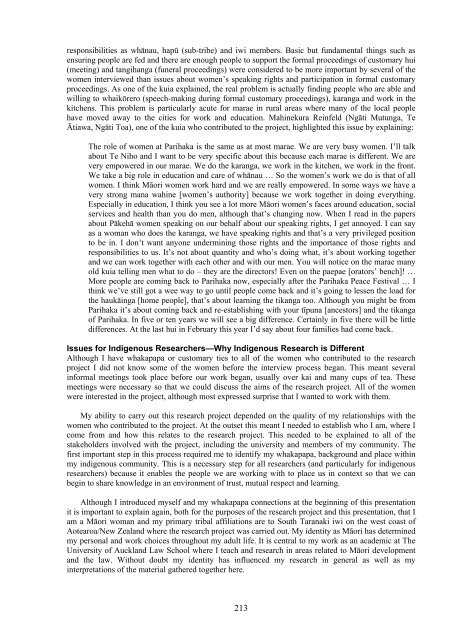traditional knowledge conference 2008 te tatau pounamu
traditional knowledge conference 2008 te tatau pounamu
traditional knowledge conference 2008 te tatau pounamu
Create successful ePaper yourself
Turn your PDF publications into a flip-book with our unique Google optimized e-Paper software.
esponsibilities as whānau, hapū (sub-tribe) and iwi members. Basic but fundamental things such asensuring people are fed and there are enough people to support the formal proceedings of customary hui(meeting) and tangihanga (funeral proceedings) were considered to be more important by several of thewomen in<strong>te</strong>rviewed than issues about women’s speaking rights and participation in formal customaryproceedings. As one of the kuia explained, the real problem is actually finding people who are able andwilling to whaikōrero (speech-making during formal customary proceedings), karanga and work in thekitchens. This problem is particularly acu<strong>te</strong> for marae in rural areas where many of the local peoplehave moved away to the cities for work and education. Mahinekura Reinfeld (Ngāti Mutunga, TeĀtiawa, Ngāti Toa), one of the kuia who contribu<strong>te</strong>d to the project, highligh<strong>te</strong>d this issue by explaining:The role of women at Parihaka is the same as at most marae. We are very busy women. I’ll talkabout Te Niho and I want to be very specific about this because each marae is different. We arevery empowered in our marae. We do the karanga, we work in the kitchen, we work in the front.We take a big role in education and care of whānau … So the women’s work we do is that of allwomen. I think Māori women work hard and we are really empowered. In some ways we have avery strong mana wahine [women’s authority] because we work together in doing everything.Especially in education, I think you see a lot more Māori women’s faces around education, socialservices and health than you do men, although that’s changing now. When I read in the papersabout Pākehā women speaking on our behalf about our speaking rights, I get annoyed. I can sayas a woman who does the karanga, we have speaking rights and that’s a very privileged positionto be in. I don’t want anyone undermining those rights and the importance of those rights andresponsibilities to us. It’s not about quantity and who’s doing what, it’s about working togetherand we can work together with each other and with our men. You will notice on the marae manyold kuia <strong>te</strong>lling men what to do – they are the directors! Even on the paepae [orators’ bench]! …More people are coming back to Parihaka now, especially af<strong>te</strong>r the Parihaka Peace Festival … Ithink we’ve still got a wee way to go until people come back and it’s going to lessen the load forthe haukāinga [home people], that’s about learning the tikanga too. Although you might be fromParihaka it’s about coming back and re-establishing with your tīpuna [ancestors] and the tikangaof Parihaka. In five or <strong>te</strong>n years we will see a big difference. Certainly in five there will be littledifferences. At the last hui in February this year I’d say about four families had come back.Issues for Indigenous Researchers—Why Indigenous Research is DifferentAlthough I have whakapapa or customary ties to all of the women who contribu<strong>te</strong>d to the researchproject I did not know some of the women before the in<strong>te</strong>rview process began. This meant severalinformal meetings took place before our work began, usually over kai and many cups of <strong>te</strong>a. Thesemeetings were necessary so that we could discuss the aims of the research project. All of the womenwere in<strong>te</strong>res<strong>te</strong>d in the project, although most expressed surprise that I wan<strong>te</strong>d to work with them.My ability to carry out this research project depended on the quality of my relationships with thewomen who contribu<strong>te</strong>d to the project. At the outset this meant I needed to establish who I am, where Icome from and how this rela<strong>te</strong>s to the research project. This needed to be explained to all of thestakeholders involved with the project, including the university and members of my community. Thefirst important s<strong>te</strong>p in this process required me to identify my whakapapa, background and place withinmy indigenous community. This is a necessary s<strong>te</strong>p for all researchers (and particularly for indigenousresearchers) because it enables the people we are working with to place us in con<strong>te</strong>xt so that we canbegin to share <strong>knowledge</strong> in an environment of trust, mutual respect and learning.Although I introduced myself and my whakapapa connections at the beginning of this presentationit is important to explain again, both for the purposes of the research project and this presentation, that Iam a Māori woman and my primary tribal affiliations are to South Taranaki iwi on the west coast ofAo<strong>te</strong>aroa/New Zealand where the research project was carried out. My identity as Māori has de<strong>te</strong>rminedmy personal and work choices throughout my adult life. It is central to my work as an academic at TheUniversity of Auckland Law School where I <strong>te</strong>ach and research in areas rela<strong>te</strong>d to Māori developmentand the law. Without doubt my identity has influenced my research in general as well as myin<strong>te</strong>rpretations of the ma<strong>te</strong>rial gathered together here.213
















